| Designation: | Lancer |
 |
|---|---|---|
| Manufacturer: | BAE Systems Land and Armament | |
| Product type: | Armoured Vehicles | |
| Name: | Fire support vehicle |
In 1999, the UK Defence Procurement Agency, acting on behalf of the UK and US governments, awarded contracts to two consortia, Lancer and SIKA, each worth £90 million and to last for 42 months. The UK and US governments shared the cost of the work equally through to mid-2002.
Under this contract, the competing Lancer and SIKA consortia were required to design a system to replace the ageing reconnaissance vehicles currently in service.
In the UK the programme is referred to as Tactical Reconnaissance Armoured Combat Equipment Requirement (TRACER), while the US calls the system the Future Scout Cavalry System (FSCS). Additional details of the overall programme are given in an earlier entry.
The role of the vehicle is to carry out day/night all-weather reconnaissance in a covert and stealthy manner, with the system being fully air transportable in a Lockheed Martin C-130 Hercules aircraft.
The Lancer Integrated Demonstrator (ID) is a fully integrated vehicle that incorporates all of the technologies and functionality required for the reconnaissance role in a C-130 transportable envelope.
The ID is representative of the company's recommended design concept. To reduce time and costs, some off-the-shelf subsystems have been incorporated.
As technology evolves, some of these will in future be much smaller and more compact as well as having increased capabilities. This especially applies to the area of the sensor package.
Within the Lancer consortium, BAE Systems (the part that was previously Marconi Land and Naval Systems) has prime leadership role and responsibility for the weapon system with United Defense having responsibility for the chassis. United Defense refer to the chassis as the Future Mobility Platform (FMP).
Raytheon is responsible for the advanced electronics and sensor suite while Alvis Vehicles is responsible for the turret structure and the telescopic sensor elevation system
The turret stabilisation and fire-control system have been provided by BAE Systems, RO Defence and turret integration was completed at their Leicester facility.
The Lancer FMP was completed early in 2002 at the United Defense facility in San Jose, California. It was then airlifted to the UK for the integration of mission equipment, turret, defensive aids suite, mast-mounted sensor package and the optimised SMI. This work was carried out at the BAE Systems integration facility in Leicester.
A key feature of the Lancer design is its open architecture and its enhanced situation awareness when compared to current vehicles. The production system would incorporate features designed to enhance reliability and supportability.
In a traditional design of armoured vehicles, the crew is split with the driver in the hull and the crew in the turret. In a departure from this traditional design, the Lancer design places the crew in the hull with the driver at the front, and to his immediate rear is the commander (right) and scout (left}.
This feature has not only saved weight but also made the vehicle more compact, so that it is fully air transportable in a Lockheed Martin C-130 Hercules transport aircraft at a combat weight of 18 tonnes.
The driver can enter the vehicle via his hatch and if required exit to his rear. There is also an emergency escape hatch in the floor. The driver has five day periscopes that provide observation through the frontal arc. A thermal camera is being provided for driving at night with the picture being displayed on a screen to his immediate front.
There is also a thermal reversing camera with the picture displayed on the same screen. The driver also has a screen that displays the immediate status of all vehicle systems, as well as a screen that shows some of the sensor and tactical information available to the commander and scout.
The commander and scout each have a roof hatch to enter the vehicle and seven periscopes for general observation over the frontal arc. The Soldier Machine Interface (SMI) was developed by BAE Systems, Avionics of Edinburgh and consists of five multifunctional displays. These wrap round displays are readily reconfigurable by the crew to suit the tactical situation.
On these screens can be displayed not only information from the wide range of sensors installed on the platform but also other tactical information from external sources.
The centre display is typically used to display a map that gives the position of the Lancer ID as well as the position of potential targets, friendly forces, sensor coverage and route planning/navigation information.
Commander and scout each have a twin handle controller to lay the main and secondary armament onto the target. Information from other platforms is provided by the US FBCB2 tactical information system.
The compact remote turret is armed with a stabilised CTA International 40 mm Case Telescoped Weapon System (CTWS) which would normally fire Armour Piercing Fin Stabilised Discarding Sabot (APFSDS) or General Purpose Round - Tracer (GPR-T) ammunition with the empty cartridge cases being ejected out of the turret. There is also a 7.62 mm coaxial machine gun.
The 40 mm CTWS is fitted for defensive purposes only. The APFSDS round will defeat light armoured vehicles, while the GPR-T is highly effective against troops in the open.
Mounted on the turret roof is a Raytheon Commanders Independent Thermal Viewer (CITV) which is standard on the M1A2 tank. This is used to lay the weapon onto the target as well as being used for general surveillance duties. Mounted around the turret are acoustic detectors that can be used to detect a variety of battlefield targets.
The main sensor package is mounted on a 5 m telescopic mast and located at the rear of the vehicle on the left side. When not required this is retracted under full armour protection.
The use of a mast-mounted sensor package contributes to the overall survivability of the Lancer ID as the vehicle itself does not have to be in direct line of sight to carry out its reconnaissance mission.
The vehicle can remain in cover or dead ground and elevate the sensor to provide the necessary sight line. This enables targets to be detected at longer range and quicker than current systems.
The sensor package features a laser range-finder/designator, day TV camera, second-generation focal plane array thermal imager and a radar.
The radar has been developed by Thales and DSTL and electronically scans the battlefield. It can rapidly detect and track moving targets. Information from the radar is fuzed with data from the electro-optical sensor to confirm known targets as well as detecting targets hidden by smoke or fog.
A BAE Systems Inertial Navigation System (INS) is fitted together with a Global Positioning System (GPS) which provides for the self-location of the platform plus sight stabilisation for accurate target location.
Data from on board and external sensors is fused with the Lancer ID to provide the crew with a complete picture of the battlefield. The Lancer ID also incorporates Wide Area Surveillance (WAS), Automatic Target Detection (ATD) and Aided Target Recognition (ATR) systems to reduce workload and improve speed and accuracy of reporting.
The system features a Hybid Electric Drive (HED) system with two sprocket electric drive motors of over half a megawatt by a battery/diesel generator hybrid power system.
The advanced power converters were developed by United Defense LP under the Defense Advanced Research Projects Agency (DARPA)/Tank-automotive and Armaments Command (TACOM) funded CHPS programme.
It has advanced Lithium-Ion batteries that are claimed to have the highest power density of any batteries in the world today. The Caterpillar diesel engine and batteries are located at the right side of the vehicle at the back.
Lancer ID is normally powered by the diesel engine, but when being used in its most stealthy mode, the batteries alone are used which provide sufficient power for 6 to 10 km. Maximum speed is 90 km/h with acceleration from 0 to 48 km/h in 9 seconds. Maximum range is about 650 km.
The system is fitted with an advanced hydropneumatic suspension system that not only provides an improved ride for the crew, but takes up less room than a conventional torsion bar suspension.
Future suspension units, tested on this programme but not fitted to the ID, would allow the overall height of the vehicle to be adjusted.
Rather than conventional metal tracks the Lancer ID has an advanced rubber band track developed by Soucy International, that is not only lighter, but also quieter.
There is also a significant reduction in vibration. This is of great importance as there is a considerable amount of Commercial-Off-The-Shelf (COTS) electronics in the vehicle whose reliability could be reduced if excessive vibration occurred.
The hull of the Lancer ID is of welded aluminium with an appliqué layer of representative armour. It is envisaged that a production vehicle would incorporate a ceramic/composite hull which has already been demonstrated under the United Defense/TACOM Composite Armored Vehicle Programme which was successfully completed several years ago.
The production system design includes stealth characteristics in its design and has a very low acoustic, radar and thermal signature. It is also fitted with combat identification, collective NBC system and automatic fire detection and suppression system for crew and engine compartments.
In addition to the reconnaissance vehicle, the UK also had a requirement for an overwatch version armed with an Anti-Tank Guided Weapon (ATGW) to replace the current Alvis Vehicles Striker armed with 4,000 m range Swingfire missiles.
To meet this requirement the Lancer team built a full scale mockup version fitted with a remote turret with four Hellfire or Brimstone ATGW in the ready to launch position and a 7.62 mm machine gun mounted in the centre.
The ATGW are mounted two either side under complete armour protection and are elevated prior to launch. This variant would use the same elevated sensor pack as the baseline Lancer vehicle. This capability is made possible by the highly modular approach to the design.
Brimstone is already in production for the Royal Air Force. It can be used in the direct or indirect fire modes and once launched is a fully fire and forget missile. Its millimetric radar seeker gives it an all-weather capability. Its tandem High Explosive Anti-Tank (HEAT) warhead can defeat targets fitted with Explosive Reactive Armour (ERA).
In addition, with the guided weapons variant the open architecture and modularity has already demonstrated the ease by which the system can be adapted for a family of vehicles.
|
||||||||||||||||||||||||||||||||||||||
Related Articles |
|
Dragoon (22.06.2007) |
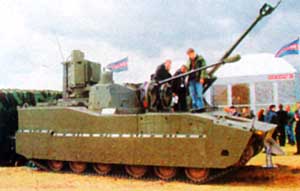 |
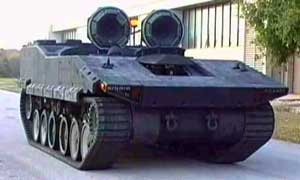 |
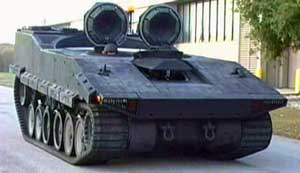 |
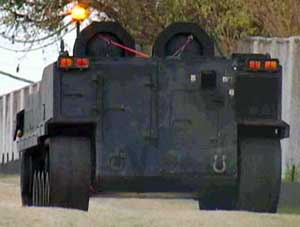 |
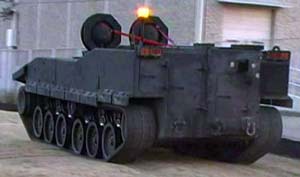 |
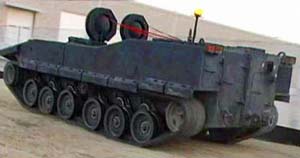 |
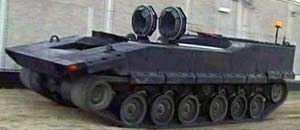 |
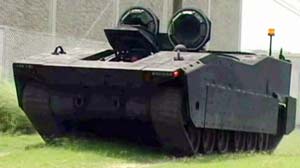 |
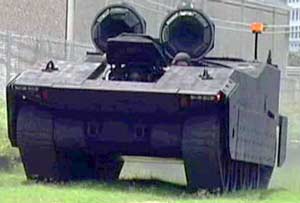 |
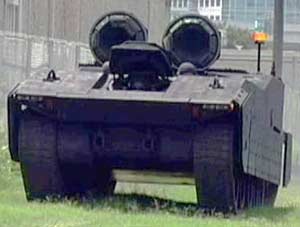 |
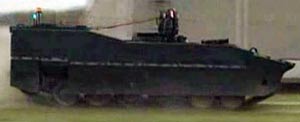 |
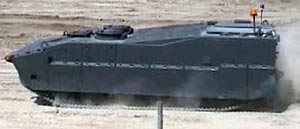 |
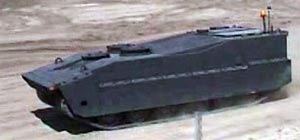 |
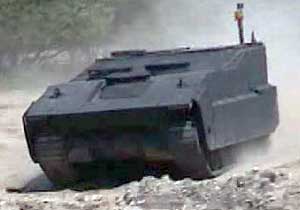 |
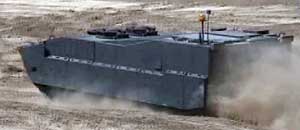 |
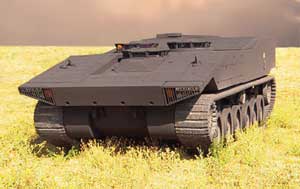 |
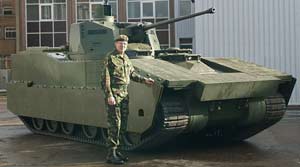 |
_sdfkjh1.jpg) |
_sdfkjh2.jpg) |
_sdfkjh3.jpg) |
_sdfkjh4.jpg) |
